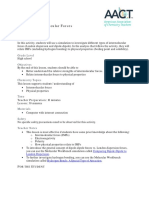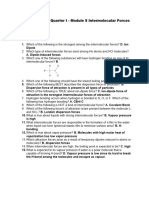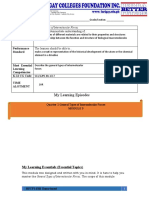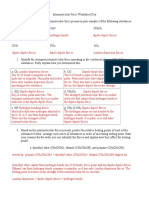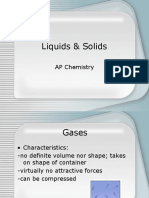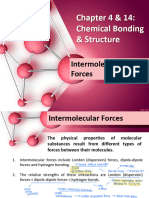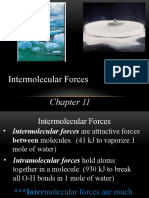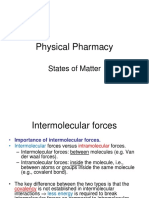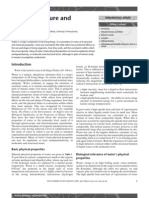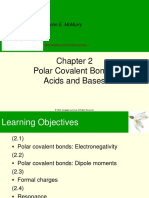Professional Documents
Culture Documents
Imf Online Activity
Imf Online Activity
Uploaded by
Philip PrasadOriginal Description:
Original Title
Copyright
Available Formats
Share this document
Did you find this document useful?
Is this content inappropriate?
Report this DocumentCopyright:
Available Formats
Imf Online Activity
Imf Online Activity
Uploaded by
Philip PrasadCopyright:
Available Formats
Activity: Intermolecular Forces
In this activity, students will use a simulation to investigate different
types of intermolecular forces and how they relate to physical properties (boiling point and solubility).
Objectives
By the end of this lesson, students should be able to
• Better understand the relative strengths of intermolecular forces.
• Relate intermolecular forces to physical properties
Part One: London-dispersion Forces
ALL covalent-bonded molecules exhibit London-dispersion forces. Nonpolar molecules have ONLY London-
dispersion forces.
London Dispersion forces are due to temporary and induced dipoles from the natural repulsion between
electrons and attraction of electrons to protons. L-D forces are the weakest IMF, but are the strongest in
nonpolar molecules. L-D force increases as the size of the nonpolar molecule surface increases, due to a
larger number of mobile electrons.
1) Watch the following video: https://www.youtube.com/watch?v=H37-r-t0bf4
2) Notice that a NONPOLAR electron cloud can repel another electron cloud if they get close enough to each
other. This temporary repulsion deforms the electron cloud and makes it temporarily polar. This
temporary dipole creates just enough attraction for nonpolar molecules to have some IMF attraction.
Part Two: Comparing dipole-dipole and L-D Forces
ALL polar molecules exhibit dipole-dipole forces due to their permanently polar structure. Polar molecules
also have L-D forces in addition to their dipole-dipole forces.
Dipole-dipole forces are another type of IMF involving permanently polar molecules. This type of IMF is
generally stronger than L-D force. In order to have dipole-dipole forces, two polar molecules must get close
enough for the opposite poles to be attracted. Dipole-dipole forces increase as the polarity of the molecule
increase (larger electronegativity difference).
1) Open the following simulation and click “Run Model”:
http://concord.org/stem-resources/comparing-dipole-dipole-london-dispersion
2) Select “pull apart two polar molecules” and make a note of the arrangement – opposites attract.
3) Play with the simulation: click-and-drag the star to “feel” how hard it is to pull apart the molecules; move the
molecule back and watch it stick together; notice that when it sticks together it always has opposite poles
attract; you can even move the star under the word “attraction” and then let go – watch as the molecules are
pulled together by the dipole-dipole forces.
4) Now select “pull apart two nonpolar molecules” and make a note that there are no +/- signs, because
these molecules are nonpolar. Play with the simulation and watch how much easier it is to pull part
these molecules. They ONLY have London-dispersion forces of attraction; no dipole-dipole forces.
5) Select “pull apart a nonpolar and polar molecule” and play with the simulation.
Part Three: Hydrogen-Bonding forces
ALL covalent molecules which have N-bonded-to-H, or O-bonded-to-H, or F-bonded-to-H exhibit hydrogen-
bonding forces. Because H is such a low electronegativity nonmetal and N, or O, or F are such high
electronegativity nonmetals, H-bonding is a VERY strong type of dipole-dipole force. Hydrogen-bonding
forces are so strong they given their own name (not dipole-dipole). Molecules with H-bonding also have L-D
forces in addition to the H-bonding forces.
Common molecules with H-bonding are: H2O, NH3, HF, C2H5OH (alcohol), CH3NH2, etc.
1) Open the following simulation and click “Run Model”:
http://concord.org/stem-resources/hydrogen-bonds-special-type-attraction
2) Begin by checking “show hydrogen bonds” and “show partial charges.” REMEMBER – water is NOT ionic.
The “+” and “-“ signs are based on low and high electronegativity and create a very polar molecule. Click
the play button to observe these water molecules as they move around and the dotted lines represent
the hydrogen-bonding that occurs.
3) Play with the simulation by clicking “cool” and watch the particles slow down and begin to get closer
together – this would eventually lead to freezing. Click “heat” and watch the particles move faster and
further apart – this would eventually lead to melting and boiling.
4) Continue to play with the simulation by checking and un-checking any of the boxes and heating/cooling
and noting the formation of hydrogen-bonding forces when particles get close together. Be sure to
check the slow-motion and watch that for a while.
FEEL the difference in IMF between actual molecules:
1) Open the following simulation and click “Run Model”:
http://concord.org/stem-resources/comparing-attractive-forces
2) Select "pull apart Br2 and Br2." Feel how difficult it is to pull apart the two molecules and record.
3) Select "pull apart H2 and H2." Feel how difficult it is to pull apart the two molecules and record.
Compare to the feeling of separating the Br2 molecules. Why was it easier to separate the H 2? What
type of forces do H2 and Br2 have?
4) Select "pull apart HBr and HBr." Feel how difficult it is to pull apart the two molecules and record. What
type of forces do HBr molecules have? Compare the strength to the forces in H2 and Br2.
5) Select "pull apart Br2 and HBr." Compare the strength of the forces.
Use your observations and PREDICT the forces in HF
6) IF you used HF and HF in this same simulation, predict the observations in the Data Table below
Relative force to pull apart Polar or nonpolar? IMF
Br2 and Br2
H2 and H2
HBr and HBr
H2 and HBr
PREDICT: HF and HF
Analysis
Considering the observed IMF and strength of those forces, complete the following questions with your best
predictions.
1) Rank the following molecules from lowest to highest boiling point: H 2, Br2, and F2. Explain your
prediction based on IMF.
2) Predict which of the following has the highest boiling point: HF or HBr. Explain your prediction based
on IMF.
3) You can play with this simulation to observe how different IMF can impact boiling point (boiling temp)
http://concord.org/stem-resources/boiling-point
4) Consider water, H2O. Predict how water’s boiling point compares to HBr and HF? Explain your
prediction based on IMF.
5) Look up the boiling points of H2, H2O, Br2, F2, HBr, and HF. Were your predictions correct? Explain.
You might also like
- Intermolecular Forces Grade 11 Lesson Plan 18 May 2021Document28 pagesIntermolecular Forces Grade 11 Lesson Plan 18 May 2021LixieNo ratings yet
- Chemistry, 2nd Edition - Julia BurdgeDocument1,121 pagesChemistry, 2nd Edition - Julia Burdgeyoribaldis olivo91% (11)
- The Mathematics of Soap Films AMS PDFDocument282 pagesThe Mathematics of Soap Films AMS PDFLuis LopezNo ratings yet
- Physical Science: Quarter 3/module 5/week 3: General Types of Intermolecular ForcesDocument12 pagesPhysical Science: Quarter 3/module 5/week 3: General Types of Intermolecular ForcesJennie KimNo ratings yet
- Chemical Principle S: Chapter 17 Properties of SolutionsDocument56 pagesChemical Principle S: Chapter 17 Properties of SolutionsjovitaNo ratings yet
- Physical Science Week 3Document18 pagesPhysical Science Week 3RAINIER DE JESUSNo ratings yet
- Intermolecular Forces ActivityDocument3 pagesIntermolecular Forces ActivityErika DockeryNo ratings yet
- 2021 IMF Packet WelchDocument9 pages2021 IMF Packet WelchbobNo ratings yet
- The Kinetic Molecular Model and Intermolecular Forces of Attraction in MatterDocument104 pagesThe Kinetic Molecular Model and Intermolecular Forces of Attraction in MatterMiguel TatlonghariNo ratings yet
- Intermolecular Forces Lesson PlanDocument4 pagesIntermolecular Forces Lesson Plancheryl.tayasNo ratings yet
- Intermolecular Forces Lab HonorsDocument8 pagesIntermolecular Forces Lab HonorsMatthew JuhlNo ratings yet
- Introduction To Intermolecular ForcesDocument8 pagesIntroduction To Intermolecular ForcesLouie DelavegaNo ratings yet
- Module 5 in Physical ScienceDocument8 pagesModule 5 in Physical ScienceDarlyn MontillaNo ratings yet
- I. Introductory Concept: SHS-Physical Science (Intermolecular Forces)Document10 pagesI. Introductory Concept: SHS-Physical Science (Intermolecular Forces)Jane182004No ratings yet
- My Learning Episodes: The Learners Demonstrate Understanding Of..Document8 pagesMy Learning Episodes: The Learners Demonstrate Understanding Of..Radzmiya SulaymanNo ratings yet
- Q3 Module 1A - Intermolecular Forces of AttractionDocument53 pagesQ3 Module 1A - Intermolecular Forces of AttractionRance Bobadilla100% (2)
- Physical Science: San Fabian, PangasinanDocument8 pagesPhysical Science: San Fabian, Pangasinankath neeveNo ratings yet
- Chapter 1 IntermolecularforcesliquidsandsolidsDocument101 pagesChapter 1 IntermolecularforcesliquidsandsolidsmarilyncasaulNo ratings yet
- LAS For Physical Science Week 5-6Document4 pagesLAS For Physical Science Week 5-6Seul AsterNo ratings yet
- Physical Science Module 5Document9 pagesPhysical Science Module 5Radzmiya SulaymanNo ratings yet
- Physical Science Week 3Document9 pagesPhysical Science Week 3Rona Grace MartinezNo ratings yet
- Types of Intermolecular Forces of AttractionDocument9 pagesTypes of Intermolecular Forces of AttractionTrisha Mae FrialaNo ratings yet
- General Chemistry 2 Q3 Module 1Document10 pagesGeneral Chemistry 2 Q3 Module 1Jennylyn CariagaNo ratings yet
- Student Activity Sheet: Intermolecular ForcesDocument3 pagesStudent Activity Sheet: Intermolecular ForcesAngela RoblesNo ratings yet
- Intermolecular Force Worksheet KeyDocument3 pagesIntermolecular Force Worksheet KeyBill alfonsoNo ratings yet
- Physci Lesson 3Document19 pagesPhysci Lesson 3wendell john medianaNo ratings yet
- ME Sci 11-12 Q3 0401 PSDocument24 pagesME Sci 11-12 Q3 0401 PSAna Pearl ColegadoNo ratings yet
- PhySci Module 3 ADM EditedDocument9 pagesPhySci Module 3 ADM EditedMark Rowen De LarnaNo ratings yet
- 101.12 IMF Fa19Document6 pages101.12 IMF Fa19Jossmyr NarceNo ratings yet
- General Chemistry 2 Q3 Module 1Document10 pagesGeneral Chemistry 2 Q3 Module 1Cess BagtasNo ratings yet
- IMF For StudentsDocument20 pagesIMF For StudentsNathaniel RemolinNo ratings yet
- Gen - Chem 11 Solids and LiquidsDocument13 pagesGen - Chem 11 Solids and Liquidschasesawadjaan142No ratings yet
- Chapter 14 - Intermolecular ForcesDocument8 pagesChapter 14 - Intermolecular ForcesRenny Romero LuzadaNo ratings yet
- CAPE Chemistry Forces of AttractionDocument8 pagesCAPE Chemistry Forces of AttractionDaniel Walsh100% (1)
- Polarity of Molecule (Autosaved)Document40 pagesPolarity of Molecule (Autosaved)Yson GonzalesNo ratings yet
- WEEK 10 - Intermolecular Forces of Attraction - 0Document16 pagesWEEK 10 - Intermolecular Forces of Attraction - 0Micz Ryan OcheaNo ratings yet
- Lecture # 13 (Liquids and Solids)Document76 pagesLecture # 13 (Liquids and Solids)hamzaali227004No ratings yet
- Imf NotesDocument1 pageImf Notesapi-182809945No ratings yet
- Lecture 1. IMFDocument33 pagesLecture 1. IMFJovito Jose PanagaNo ratings yet
- PS Q3 Module3 WK3Document12 pagesPS Q3 Module3 WK3Jason PojasNo ratings yet
- 115 Intermolecular Force Worksheet KeyDocument2 pages115 Intermolecular Force Worksheet Keyada wangNo ratings yet
- IMF Lecture 1 - Types of IMF'sDocument35 pagesIMF Lecture 1 - Types of IMF'sPrivacy NutNo ratings yet
- IMF Lecture 1 - Types of IMF'sDocument35 pagesIMF Lecture 1 - Types of IMF'sGoatNo ratings yet
- Group 5 ReportingDocument10 pagesGroup 5 ReportingJay Em Kristel MengulloNo ratings yet
- Core-Physical Science Q1 SLM - 5Document17 pagesCore-Physical Science Q1 SLM - 5Christopher Agustin Tambogon Lpt100% (1)
- Lesson 1Document30 pagesLesson 1pulbopulNo ratings yet
- Intermolecular Forces: Liquids, Solids, and Phase ChangesDocument57 pagesIntermolecular Forces: Liquids, Solids, and Phase ChangesB13, Jerex MaxilumNo ratings yet
- Intermolecular ForcesDocument14 pagesIntermolecular ForcesJuss ChillinNo ratings yet
- Lesson 4Document3 pagesLesson 4rhaineNo ratings yet
- General Chemistry 2 February Monthly Test ReviewerDocument4 pagesGeneral Chemistry 2 February Monthly Test ReviewerAngela SernatNo ratings yet
- Gen Chem 2 Q3 Module 1 Week1Document10 pagesGen Chem 2 Q3 Module 1 Week1Rejie Nel AquinoNo ratings yet
- Lesson 3 - Intermolecular Forces of AttractionDocument43 pagesLesson 3 - Intermolecular Forces of AttractionFreshieeNo ratings yet
- Lesson 12 - IMF 2Document22 pagesLesson 12 - IMF 2Jenny YoonNo ratings yet
- General Chemistry 2 Q3 Module 1Document11 pagesGeneral Chemistry 2 Q3 Module 1Jennylyn CariagaNo ratings yet
- Intermolecular Forces, Liquids, and SolidsDocument47 pagesIntermolecular Forces, Liquids, and Solidsapi-683027695No ratings yet
- Reveiw - CH06 Bonding KEYDocument5 pagesReveiw - CH06 Bonding KEYMae Seihdrean Bautistä - MAEd Sci 1No ratings yet
- 4 14 Chemical Bonding 4 Intermolecular Forces JLDocument46 pages4 14 Chemical Bonding 4 Intermolecular Forces JLFN5052023 PRAMITA MAHENDRANNo ratings yet
- Intermolecular Forces WorksheetDocument3 pagesIntermolecular Forces WorksheetMark John DumaslanNo ratings yet
- Lesson 1 Kinetic Molecular Model of Liquids and SolidsDocument26 pagesLesson 1 Kinetic Molecular Model of Liquids and SolidsLyndy PantaoNo ratings yet
- DLP EFFECTS OF IMFA (AutoRecovered)Document7 pagesDLP EFFECTS OF IMFA (AutoRecovered)Rodelyn Dahay CalluengNo ratings yet
- Student Exploration: Polarity and Intermolecular ForcesDocument7 pagesStudent Exploration: Polarity and Intermolecular ForcesZhaoxiaotang EstherNo ratings yet
- 02 Intermolecular ForcesDocument13 pages02 Intermolecular ForcesRyan M. RamlawiNo ratings yet
- A-Level Chemistry Revision: Cheeky Revision ShortcutsFrom EverandA-Level Chemistry Revision: Cheeky Revision ShortcutsRating: 4 out of 5 stars4/5 (5)
- Module 1 - KINETIC MOLECULAR THEORY, IMF, AND PROPERTIES OF LIQUIDDocument5 pagesModule 1 - KINETIC MOLECULAR THEORY, IMF, AND PROPERTIES OF LIQUIDGabo AlfonsoNo ratings yet
- Chem62014 ExamDocument16 pagesChem62014 ExamAAVANINo ratings yet
- Ethiopian Secondary School Lleaving Certificate: EquilibriumDocument21 pagesEthiopian Secondary School Lleaving Certificate: EquilibriumHenok GirmaNo ratings yet
- Chapter 2 Human Anatomy & Physiology (Marieb)Document3 pagesChapter 2 Human Anatomy & Physiology (Marieb)JayjayNo ratings yet
- CHEM1643 Organic Chemistry 2024Document179 pagesCHEM1643 Organic Chemistry 2024Tevin TembaNo ratings yet
- Mark Scheme (Results) January 2023Document33 pagesMark Scheme (Results) January 2023youssof aminNo ratings yet
- BigBang Theory Act SheetsDocument9 pagesBigBang Theory Act SheetsMichael Padilla EsmallaNo ratings yet
- Chemistry SL P2Document7 pagesChemistry SL P2Juan Fernando Velasco ForeroNo ratings yet
- Chapter 2 - States of MatterDocument38 pagesChapter 2 - States of MatternnooorNo ratings yet
- FLGX113 Su2.1Document40 pagesFLGX113 Su2.1Jason Van Den HeeverNo ratings yet
- BIO 156 Chapter 2 PowerpointDocument24 pagesBIO 156 Chapter 2 PowerpointDrPearcyNo ratings yet
- Class 2 - Elements Atoms Carbon - OwlDocument22 pagesClass 2 - Elements Atoms Carbon - OwlLinda WuNo ratings yet
- Biology 25: Human Biology: Prof. Gonsalves Los Angeles City College Loosely Based On Mader's Human Biology, 7 EditionDocument119 pagesBiology 25: Human Biology: Prof. Gonsalves Los Angeles City College Loosely Based On Mader's Human Biology, 7 EditionRhaine EstebanNo ratings yet
- Water Structure and Properties PDFDocument7 pagesWater Structure and Properties PDFfajar_setia100% (2)
- Q3 - QUIZ 2 - Gen Chem 2Document3 pagesQ3 - QUIZ 2 - Gen Chem 2Jennette BelliotNo ratings yet
- 11th Chem Re-Sendup Paper-2Document2 pages11th Chem Re-Sendup Paper-2tahir zamanNo ratings yet
- عضوية ١Document28 pagesعضوية ١ManWol JangNo ratings yet
- GCE-Chemistry-467-Summer2022-AS 1, Basic Concepts in Physical and Inorganic Chemistry-PaperDocument22 pagesGCE-Chemistry-467-Summer2022-AS 1, Basic Concepts in Physical and Inorganic Chemistry-PaperDavid McFaulNo ratings yet
- BIOCHEMDocument2 pagesBIOCHEMDenisse Angelie CastroNo ratings yet
- Dielectric PolarizationDocument49 pagesDielectric Polarizationshekhar kumarNo ratings yet
- Dielectric Properties of MatterDocument11 pagesDielectric Properties of MatterTanima DeyNo ratings yet
- Reviewing The Effect of Magnetization of Fuel Over The Efficiency of IC EngineDocument6 pagesReviewing The Effect of Magnetization of Fuel Over The Efficiency of IC EngineIJRASETPublicationsNo ratings yet
- Chap. 4: Non-Aqueous SolventsDocument9 pagesChap. 4: Non-Aqueous Solventsmd mithu100% (1)
- Physical Science: Quarter 1 - Module 3: Polarity of MoleculesDocument27 pagesPhysical Science: Quarter 1 - Module 3: Polarity of MoleculesArthur Laurel100% (1)
- A Course in Pigment GrindingDocument8 pagesA Course in Pigment GrindingBojana VukovicNo ratings yet
- Chapter 2 (Mcmurry - 9th Edition)Document60 pagesChapter 2 (Mcmurry - 9th Edition)Paolo NaguitNo ratings yet
- Maders Understanding Human Anatomy and Physiology 8th Edition Longenbaker Test BankDocument59 pagesMaders Understanding Human Anatomy and Physiology 8th Edition Longenbaker Test Bankdaisy100% (35)






